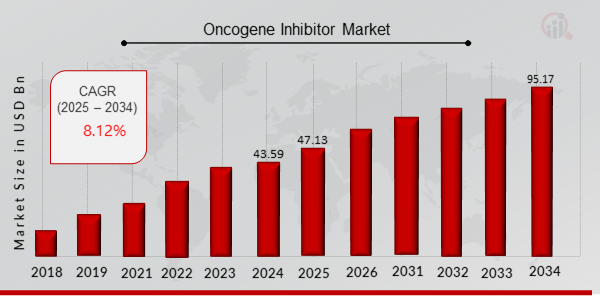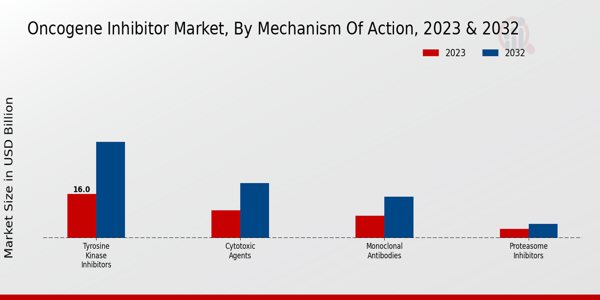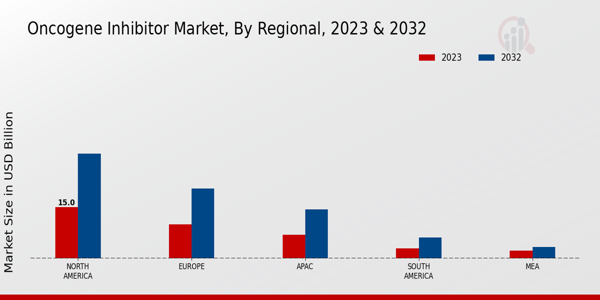Oncogene Inhibitor Market Overview
As per MRFR analysis, the Oncogene Inhibitor Market Size was estimated at 43.59 (USD Billion) in 2024. The Oncogene Inhibitor Market Industry is expected to grow from 47.13 (USD Billion) in 2025 to 95.17 (USD Billion) till 2034, at a CAGR (growth rate) is expected to be around 8.12% during the forecast period (2025 - 2034).
Key Oncogene Inhibitor Market Trends Highlighted
The Global Oncogene Inhibitor Market has growth drivers such as increase in exposure to cancer around the world and improvement in biotechnology that makes creating new drugs easier. Increase in emphasis on customized therapy has meant that more precision medicine is being employed, thereby making the treatment more effective. In addition, the increasing R&D expenditure by the drug innovators is also encouraging the development of oncogene inhibitors. All these drivers enhance the growth of the market as the number of treatment opportunities does increase for cancer patients. Market prospects can be seized by developing new oncogene inhibitors that target whatever medical demand is not yet met.
It would be valuable to develop strategies like collaborations between biotech firms as well as research institutions to better understand cancer mechanisms. Further, the investigation of such integrative strategies that promote the use of oncogenic inhibitor and other treatment will improve the efficacy of cancer treatment. Moreover, the potential for expansion in these emerging markets is enormous. This is because the increased spending and awareness on healthcare will lead to better access to the new cancer treatment options. There is also a recent development in the cancer therapies where the focus is directed towards combined therapies which appear to be the direction oncology practices are heading towards. The use of biomarkers in patient stratification enables more appropriate therapy selection in relation to specific patient characteristics which increases efficacy and decreases adverse effects.
Moreover, regulatory changes are also enabling better approvals in a quicker manner for the new therapies which change the dynamics of the market altogether. In addition, with the emergence of digital health solutions, patients can be monitored closely and be able to adhere to treatment protocols which further catalyzes the growth of the market. These are the emerging trends in the market that will help continue to push the development of oncogene inhibitors in the battle against cancer.

Source: Primary Research, Secondary Research, MRFR Database and Analyst Review
Oncogene Inhibitor Market Drivers
Rising Incidence of Cancer
The Global Oncogene Inhibitor Market Industry is witnessing significant growth due to the increasing incidence of cancer across the globe. As cancer becomes more prevalent, there is an escalating demand for effective treatment options, particularly targeted therapies like oncogene inhibitors. This rise is not only attributed to lifestyle factors but also to advancements in diagnostic techniques, which allow for earlier detection of various cancer types.The need for personalized medicine has also intensified the focus on targeting specific oncogenes, driving research and development efforts. As the population ages and environmental factors contribute to more cancer cases, the Global Oncogene Inhibitor Market Industry is set for expansion, with pharmaceutical companies investing significantly in developing innovative treatments. These treatments aim to improve patient outcomes and offer hope to those affected by these life-threatening diseases, thereby propelling the market forward.Moreover, as awareness regarding genetic mutations linked to cancer increases, healthcare professionals and patients are more inclined to explore oncogene inhibitors as viable treatment options, further accelerating market growth. This driver is expected to play a crucial role in shaping the future landscape of the oncogene inhibitor market as it fosters ongoing improvements in therapeutic strategies and outcomes.
Technological Advancements in Drug Development
Technological advancements play a pivotal role in the growth of the Global Oncogene Inhibitor Market Industry. Innovations in genomics, proteomics, and molecular biology are revolutionizing how oncogene inhibitors are discovered and developed. These technologies facilitate the identification of specific oncogenes involved in cancer progression, leading to the design of targeted therapies that can effectively inhibit cancer growth. Additionally, improved drug delivery systems are being developed to enhance the bioavailability and efficacy of these inhibitors, making them more effective for patients.The integration of Artificial Intelligence and Machine Learning in drug development processes streamlines research and increases the likelihood of successful clinical outcomes. As technology continues to evolve, the ability to create more precise and personalized treatments is expected to significantly impact the Global Oncogene Inhibitor Market Industry, fostering an environment ripe for new and innovative therapy options.
Increased Government and Private Sector Funding
The Global Oncogene Inhibitor Market Industry is being bolstered significantly by increased funding from both government and private sectors. This funding is crucial for the research and development of new oncogene inhibitors. Numerous initiatives are being launched worldwide to streamline drug discovery processes and accelerate the development of effective cancer treatments. Such efforts include grants, financial incentives, and collaborative projects aimed at fostering innovation in the oncology sector.With more resources being allocated towards the fight against cancer, the oncogene inhibitor market is expected to witness substantial growth. The partnership between private entities and public organizations further enhances the capability to bring promising therapies to market more swiftly, ultimately improving patient access to these life-saving treatments.
Oncogene Inhibitor Market Segment Insights:
Oncogene Inhibitor Market Mechanism of Action Insights
The Global Oncogene Inhibitor Market exhibits a comprehensive segmentation by Mechanism of Action, highlighting varying types of treatment strategies, including Tyrosine Kinase Inhibitors, Cytotoxic Agents, Monoclonal Antibodies, and Proteasome Inhibitors. In 2023, the overall market is valued at 37.28 USD Billion, showcasing a robust growth trajectory leading towards an estimated 75.1 USD Billion by 2032. Among these mechanisms, Tyrosine Kinase Inhibitors lead significantly, valued at 16.0 USD Billion in 2023 and expected to rise to 35.0 USD Billion by 2032, clearly dominating the market due to their effectiveness in targeting specific oncogenic signaling pathways.They play a critical role in the treatment of various cancers by inhibiting growth factor receptors that are often mutated in cancer cases. Cytotoxic Agents, holding a valuation of 10.0 USD Billion in 2023, are pivotal as they directly kill rapidly dividing cells and are commonly utilized in chemotherapy regimens, thus demonstrating significant utility and market importance as they support aggressive cancer management.
Furthermore, Monoclonal Antibodies, valued at 8.0 USD Billion, represent an innovative class of targeted therapy which offers benefits in specificity and reduced side effects compared to traditional therapies; their market is expected to reach 15.0 USD Billion by 2032, reflecting growing adoption in both early and advanced-stage cancers.Proteasome Inhibitors, while comparatively smaller in the market at 3.28 USD Billion in 2023, are gaining traction due to their unique ability to disrupt cellular protein degradation processes, which is essential in the treatment of multiple myeloma and certain lymphomas, hence marking a significant area of opportunity within the Global Oncogene Inhibitor Market. The diverse Mechanism of Action approaches not only indicate the segmented valuation but also reflect the evolving landscape within the oncology treatment arena, highlighting trends towards personalized medicine and increased effectiveness across the board.The interplay of these mechanisms creates a rich environment for future growth, guided by innovation, evolving patient needs, and ongoing clinical research. Additionally, market growth is bolstered by technological advancements and regulatory support, which further empowers the development of new therapies within each mechanism of action. Each of these mechanisms brings vital and significant contributions to improved patient outcomes, thus generating a conducive atmosphere for ongoing investments and research within the Global Oncogene Inhibitor Market.

Source: Primary Research, Secondary Research, MRFR Database and Analyst Review
Oncogene Inhibitor Market Therapeutic Application Insights
The 'Global Oncogene Inhibitor Market' is expected to hold a value of 37.28 billion USD in 2023, showcasing substantial growth potential in the coming years. A significant portion of this market relates to therapeutic applications for various types of cancers, including Breast Cancer, Lung Cancer, Colorectal Cancer, Melanoma, and Leukemia. Breast Cancer continues to be a dominant area, reflecting its high prevalence and the ongoing need for effective treatments. Lung Cancer is also critical, often leading to mortality rates, which places emphasis on innovative therapies in this segment.Colorectal Cancer represents a substantial market share due to its increasing incidence globally. Meanwhile, Melanoma, though rarer, has shown a rising demand for specialized oncogene inhibitors, driven by advancements in targeted therapies. Leukemia remains vital due to its impact on pediatric and adult populations, reinforcing the necessity for advanced treatment options. The 'Global Oncogene Inhibitor Market revenue' is supported by continual research and development, creating opportunities for innovative therapies while navigating challenges such as high treatment costs and regulatory hurdles, thus shaping market growth and overall industry dynamics.
Oncogene Inhibitor Market Distribution Channel Insights
The Distribution Channel segment of the Global Oncogene Inhibitor Market plays a crucial role in delivering cancer treatment options to patients effectively. As of 2023, the market was valued at 37.28 billion USD, reflecting the growing demand for oncogene inhibitors across various channels of distribution. Hospital Pharmacies are a significant contributor to the market, as they provide immediate access to necessary medications for patients receiving treatment in clinical settings. Retail Pharmacies also maintain a substantial share, benefiting from patient convenience and the ability to offer personalized care and counseling.Online Pharmacies have emerged as a vital distribution channel, providing easy access for patients to medications, especially for those managing treatment at home. This channel has gained momentum due to the increasing trend towards digital healthcare, particularly in the wake of recent global health challenges. Additionally, the Global Oncogene Inhibitor Market segmentation highlights how these channels work synergistically to enhance patient reach and support treatment adherence, ultimately driving market growth and responding to the needs of the oncology community.
Oncogene Inhibitor Market Drug Class Insights
The Global Oncogene Inhibitor Market is projected to be valued at 37.28 billion USD in 2023, reflecting a robust interest in innovative therapies aimed at combating cancer through targeted treatment methods. This evolving market is categorized under Drug Class into various segments, with Small Molecule Drugs, Biologics, and Combination Therapies playing significant roles. Small Molecule Drugs are vital due to their ability to penetrate cell membranes and inhibit specific oncogenes, showcasing their integral role in personalized medicine. Biologics are also of importance, offering advanced therapeutic options derived from living organisms, thus presenting unique mechanisms of action against cancer cells.Furthermore, Combination Therapies have emerged as a prevalent strategy to enhance efficacy, often integrating different modes of action to overcome resistance. The alignment of these drug classes with current trends toward personalized and innovative cancer treatments continues to drive market growth, presenting opportunities for development and expansion in the sector. The ongoing advancements and research in the Drug Class segment highlight its critical role in shaping the landscape of oncology treatment options, contributing to the overall Global Oncogene Inhibitor Market revenue.
Oncogene Inhibitor Market Regional Insights
The Global Oncogene Inhibitor Market remains robust, reflecting significant revenue generation across various regions. In 2023, North America will lead with a valuation of 15.0 USD Billion, expected to grow to 30.69 USD Billion by 2032, dominating the market due to advanced healthcare infrastructure and substantial investment in research and development. Europe follows closely with a market valuation of 10.0 USD Billion in 2023, projected to reach 20.47 USD Billion, benefiting from a strong regulatory framework and increasing prevalence of cancer. The APAC region shows promising growth with a current valuation of 7.0 USD Billion, doubling to 14.37 USD Billion by 2032, driven by rising healthcare accessibility and a growing patient population.South America and MEA demonstrate smaller market footprints at 3.0 USD Billion and 2.28 USD Billion, respectively in 2023, but they signify emerging opportunities with growth rates that reflect increasing investments in healthcare technologies and awareness of targeted therapies. Together, these regions contribute to a dynamic landscape in the Global Oncogene Inhibitor Market, driven by trends in personalized medicine and the ongoing battle against oncogene-driven cancers.
Source: Primary Research, Secondary Research, MRFR Database and Analyst Review
Oncogene Inhibitor Market Key Players and Competitive Insights:
The Global Oncogene Inhibitor Market is an evolving arena driven by the increasing prevalence of various cancers and the rising demand for targeted therapies that provide better treatment outcomes with fewer side effects. Companies within this sector are actively engaged in research and development to introduce innovative therapies that specifically target oncogenes responsible for cancer progression. Competitive dynamics in this market are characterized by constant technological advancements, collaborations, mergers, and acquisitions, along with strategic partnerships aimed at gaining a competitive edge. The landscape is continually shifting as companies strive to capitalize on emerging opportunities and respond to regulatory changes that impact drug approvals and market accessibility.Pfizer is a prominent player in the Global Oncogene Inhibitor Market, recognized for its substantial contributions through cutting-edge research and an extensive portfolio of oncogene-targeted therapies. The company has established a strong market presence by leveraging its robust clinical development programs and a diverse array of therapeutic options. Pfizer’s strengths lie in its ability to efficiently navigate regulatory pathways, allowing for timely product launches and widespread distribution. Additionally, the company has invested heavily in collaborations with academic institutions and research organizations to further enhance its drug discovery capabilities.
Its global reach and established relationships with healthcare providers contribute to a significant competitive advantage, enabling Pfizer to effectively capture market share in the oncogene inhibitor segment.Amgen is another key player in the Global Oncogene Inhibitor Market, known for its innovative approaches to treating cancer by targeting specific oncogenes. The company's strategy emphasizes the development of novel therapeutics that address unmet medical needs in oncology, which has enabled Amgen to carve out a substantial niche within the competitive landscape. Amgen's strengths include a commitment to extensive research and development efforts, resulting in a pipeline of promising candidates. Their established reputation for scientific excellence and ability to produce high-quality, effective therapies have bolstered their market position. Furthermore, Amgen's dedication to patient-centric solutions helps foster strong loyalty among healthcare practitioners and patients alike, enhancing their competitive stance in the oncogene inhibitor arena.
Key Companies in the Oncogene Inhibitor Market Include:
-
Pfizer
-
Amgen
-
Merck
-
Takeda
-
Bristol Myers Squibb
-
Eli Lilly
-
AbbVie
-
GSK
-
Roche
-
Horizon Therapeutics
-
AstraZeneca
-
Bayer
-
Novartis
-
Incyte
-
Sanofi
Oncogene Inhibitor Market Industry Developments
Recent developments in the Global Oncogene Inhibitor Market reflect significant growth and innovation, primarily driven by key players such as Pfizer, Amgen, Merck, and Bristol Myers Squibb. These companies have been consistently advancing their product pipelines, with ongoing clinical trials for novel inhibitors aiming to target specific oncogenes more effectively. In terms of mergers and acquisitions, noteworthy activity includes Bristol Myers Squibb's strategic acquisition of a promising biotech firm to enhance its oncology portfolio, alongside Merck's collaboration with other biotech enterprises to accelerate research on combination therapies. The competitive landscape is also marked by significant investments in research and development by Roche and AstraZeneca, particularly in immuno-oncology treatments. Additionally, Eli Lilly and AbbVie are expanding their reach through partnerships aimed at bringing more targeted therapies to market, showcasing a vibrant atmosphere driven by collaboration and innovation. As a result, the market is witnessing an uptick in investment and consumer demand, influencing valuations and impacting overall growth prospects within the oncogene inhibitor sector, prompting companies to bolster their offerings to meet evolving patient needs.
Oncogene Inhibitor Market Segmentation Insights
Oncogene Inhibitor Market Mechanism of Action Outlook
- Tyrosine Kinase Inhibitors
- Cytotoxic Agents
- Monoclonal Antibodies
- Proteasome Inhibitors
Oncogene Inhibitor Market Therapeutic Application Outlook
- Breast Cancer
- Lung Cancer
- Colorectal Cancer
- Melanoma
- Leukemia
Oncogene Inhibitor Market Distribution Channel Outlook
- Hospital Pharmacies
- Retail Pharmacies
- Online Pharmacies
Oncogene Inhibitor Market Drug Class Outlook
- Small Molecule Drugs
- Biologics
- Combination Therapies
Oncogene Inhibitor Market Regional Outlook
- North America
- Europe
- South America
- Asia Pacific
- Middle East and Africa
Oncogene Inhibitor Market Report Scope
| Report Attribute/Metric |
Details |
|
Market Size 2024
|
43.59 (USD Billion)
|
|
Market Size 2025
|
47.13 (USD Billion)
|
|
Market Size 2034
|
95.17 (USD Billion)
|
|
Compound Annual Growth Rate (CAGR)
|
8.12 % (2025 - 2034)
|
|
Report Coverage
|
Revenue Forecast, Competitive Landscape, Growth Factors, and Trends
|
|
Base Year
|
2024
|
|
Market Forecast Period
|
2025 - 2034
|
|
Historical Data
|
2020 - 2024
|
| Market Forecast Units |
USD Billion |
| Key Companies Profiled |
Pfizer, Amgen, Merck, Takeda, Bristol Myers Squibb, Eli Lilly, AbbVie, GSK, Roche, Horizon Therapeutics, AstraZeneca, Bayer, Novartis, Incyte, Sanofi |
| Segments Covered |
Mechanism of Action, Therapeutic Application, Distribution Channel, Drug Class, Regional |
| Key Market Opportunities |
Rising cancer prevalence, Advanced personalized therapies, Increased R investments, Favorable regulatory frameworks, Expanding target patient demographics |
| Key Market Dynamics |
Growing cancer prevalence, Increased R investments, Expanding target drug pipeline, Rising personalized medicine demand, Favorable regulatory environment |
| Countries Covered |
North America, Europe, APAC, South America, MEA |
Frequently Asked Questions (FAQ) :
The Global Oncogene Inhibitor Market is expected to be valued at 75.1 USD Billion by 2034.
In 2023, the Global Oncogene Inhibitor Market is valued at 37.28 USD Billion.
The expected CAGR for the Global Oncogene Inhibitor Market is 8.1% from 2025 to 2034.
North America holds the largest market share, valued at 15.0 USD Billion in 2023.
The market size for Tyrosine Kinase Inhibitors is expected to reach 35.0 USD Billion by 2034.
The market for Cytotoxic Agents is anticipated to grow from 10.0 USD Billion in 2023 to 20.0 USD Billion by 2034.
Key players in the market include Pfizer, Amgen, Merck, and Bristol Myers Squibb, among others.
The market size for Monoclonal Antibodies is projected to be valued at 15.0 USD Billion by 2034.
The market size in the APAC region is valued at 7.0 USD Billion in 2023.
The market size for Proteasome Inhibitors is expected to grow to 5.1 USD Billion by 2034.

















